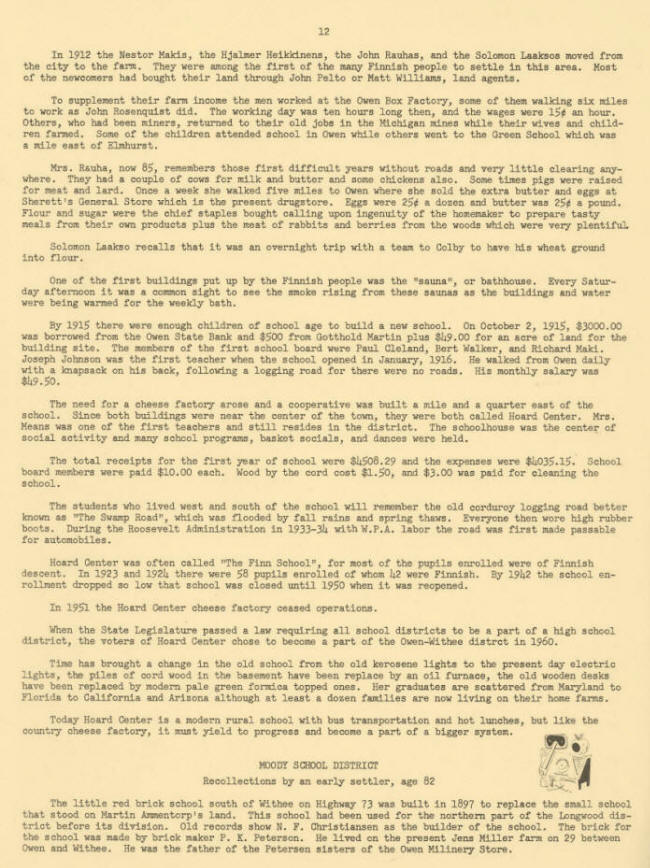|
[Memory
Trails Index]
Transcription
Janet Schwarze
In 1912 the
Nestor Makis, the Hjalmer Heikkinens, the John Rauhas, and the
Solomon Laaksos moved from the city to the farm. They were among the
first of the many Finnish people to settle in this area. Most of the
newcomers had bought their land through John Pelto or Matt Williams,
land agents.
To supplement their farm income the men worked at the Owen Box Factory, some of
them walking six miles to work as John Rosenquist did. The working day was ten
hours long then, and the wages were l5 an hour. Others, who had been miners,
returned to their old jobs in the Michigan mines while their wives and children
farmed. Some of the children attended school in Owen while others went to the
Green School which was a mile east of Elmhurst.
Mrs. Rauha, now 85, remembers those first difficult years without roads and very
little clearing anywhere. They had a couple of cows for milk and butter and some
chickens also. Some times pigs were raised for meat and lard. Once a week she
walked five miles to Owen where she sold the extra butter and eggs at Sherett’s
General Store which is the present drugstore. Eggs were 25 a dozen and butter
was 25 a pound. Flour and sugar were the chief staples bought calling upon
ingenuity of the homemaker to prepare tasty meals from their own products plus
the meat of rabbits and berries from the woods which were very plentiful
Solomon Laakso recalls that it was an overnight trip with a team to Colby to
have his wheat ground into flour.
One of the first buildings put up by the Finnish people was the “sauna”, or
bathhouse. Every Saturday afternoon it was a common sight to see the smoke
rising from these saunas as the buildings and water were being warmed for the
weekly bath.
By 1915 there were enough children of school age to build a new school. On
October 2, 1915, $3000.00 was borrowed from the Owen State Bank and $500 from
Gotthold Martin plus $149.00 for an acre of land for the building site. The
members of the first school board were Paul Cleland, Bert Walker, and Richard
Maki. Joseph Johnson was the first teacher when the school opened in January,
1916. He walked from Owen daily with a knapsack on his back, following a logging
road for there were no roads. His monthly salary was
$149.50.
The need for a cheese factory arose and a cooperative was built a mile and a
quarter east of the school. Since both buildings were near the center of the
town, they were both called Hoard Center. Mrs. Means was one of the first
teachers and still resides in the district. The schoolhouse was the center of
social activity and many school programs, basket socials, and dances were held.
The total receipts for the first year of school were $14508.29 and the expenses
were $14035.15. School board members were paid $10.00 each. Wood by the cord
cost $1.50, and $3.00 was paid for cleaning the school.
The students who lived west and south of the school will remember the old
corduroy logging road better known as "The Swamp Road”, which was flooded by
fall rains and spring thaws. Everyone then wore high rubber boots. During the
Roosevelt Administration in 1933—314 with W.P.A. labor the road was first made
passable for automobiles.
Hoard Center was often called “The Finn School”, for most of the pupils enrolled
were of Finnish descent. In 1923 and 19214 there were 58 pupils enrolled of whom
142 were Finnish. By 19142 the school enrollment dropped so low that school was
closed until 1950 when it was reopened.
In 1951 the Hoard Center cheese factory ceased operations.
When the State Legislature passed a law requiring all school districts to be a
part of a high school district, the voters of Hoard Center chose to become a
part of the Owen—Withee district in 1960. Time has brought a change in the old
school from the old kerosene lights to the present day electric lights, the
piles of cord wood in the basement have been replace by an oil furnace, the old
wooden desks have been replaced by modern pale green Formica topped ones. Her
graduates are scattered from Maryland to Florida to California and Arizona
although at least a dozen families are now living on their home farms.
Today Hoard Center is a modern rural school with bus transportation and hot
lunches, but like the country cheese factory, it must yield to progress and
become a part of a bigger system.
MOODY SCHOOL DISTRICT
Recollections by- an early settler, age 82
The little red brick school south of Withee on Highway 73 was built in 1897 to
replace the small school that stood on Martin Ammentorp’s land. This school had
been used for the northern part of the Longwood district before its division.
Old records show N. F. Christiansen as the builder of the school. The brick for
the school was made by brick maker P. K. Peterson. He lived on the present Jens
Miller farm on 29 between Owen and Withee. He was the father of the Petersen
sisters of the Owen Millinery Store.
[Next]
[Memory
Trails Index]
|
